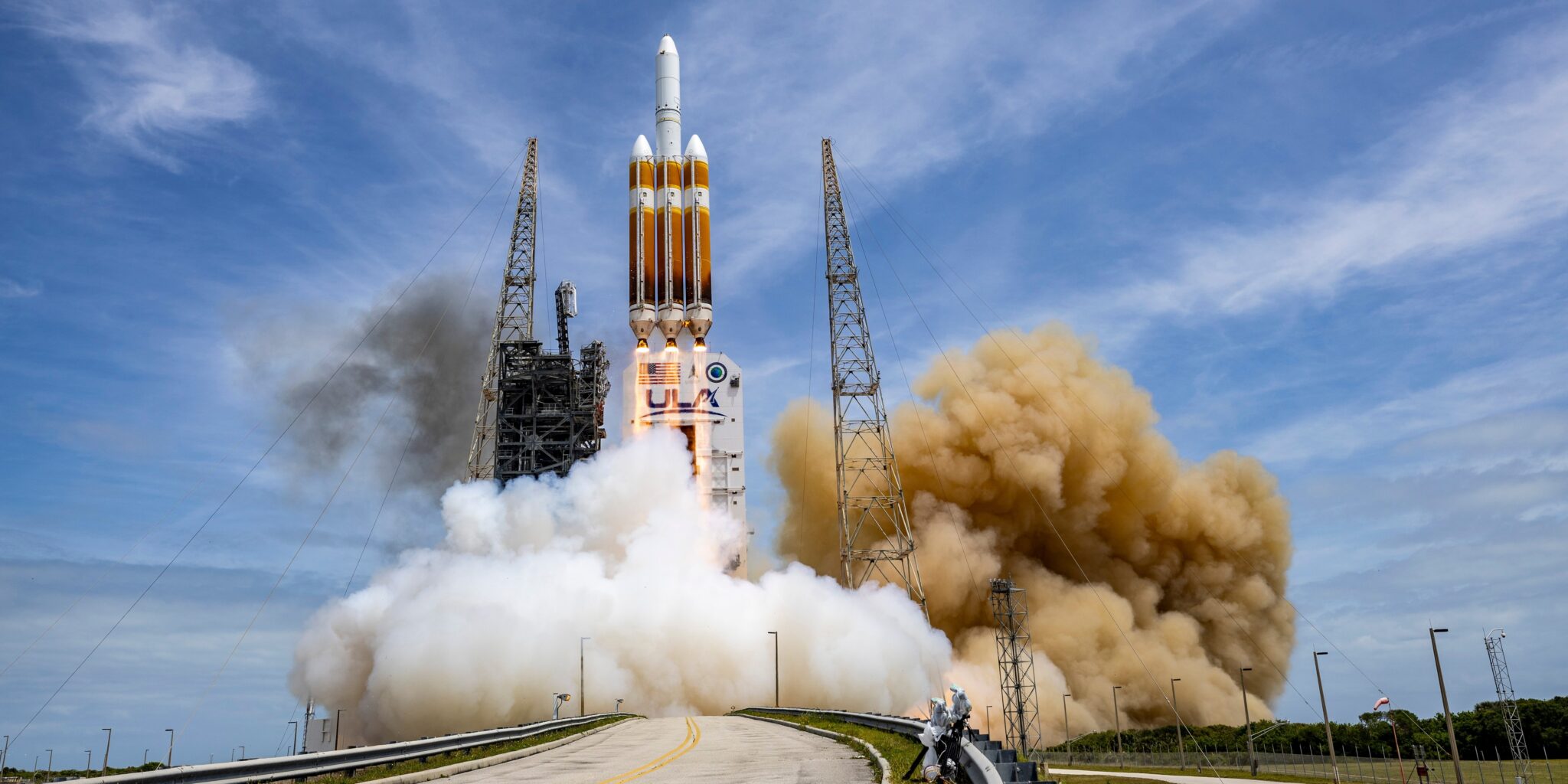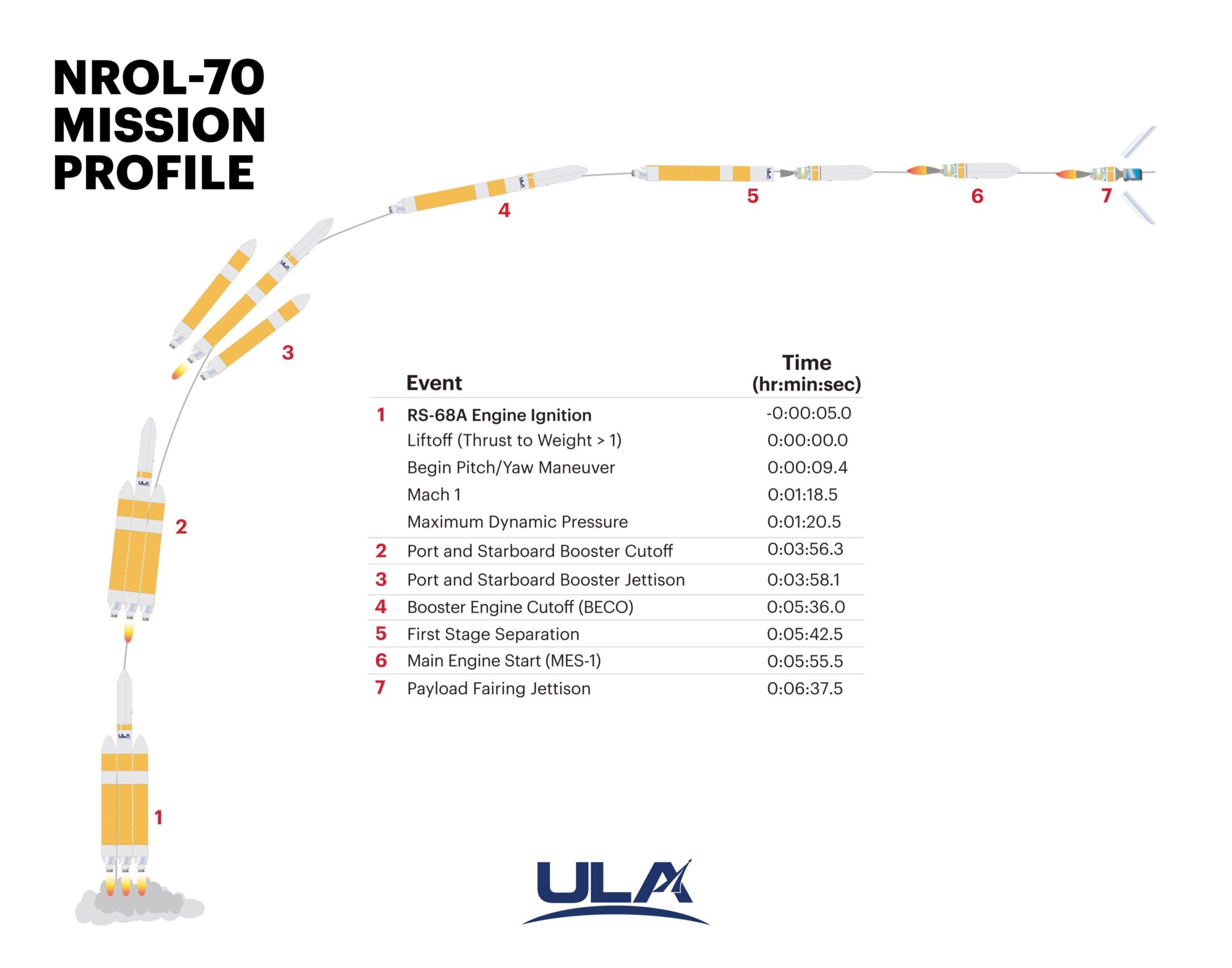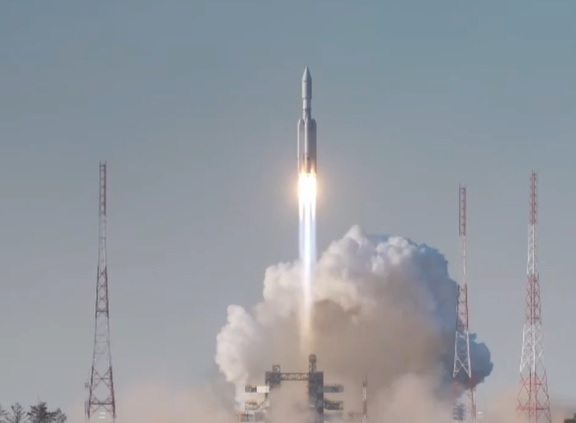A pair of major launches, that took place just days apart in April, illustrate how far Russia has lost its way from the days when it was at the forefront of rocket launch technology. The first, from the US, was a swansong: the Delta IV Heavy’s last flight. The other, from Russia, was the launch of the Angara-5 from its new launch site, the Vostochny Cosmodrome.

The final ULA-operated Delta IV Heavy lifts off from SLC-37 Cape Canaveral on 9 April 2024. Courtesy: ULA
The Delta IV Heavy’s last flight
The final launch of the Delta IV Heavy (the formal name of the upgraded version is the Delta IVH-4050H Upr) had been planned for 28 March but was delayed by nearly two weeks due to a gaseous nitrogen pump failure. It finally took place at 1653 GMT on 9 April from Cape Canaveral, Florida, carrying the NRO L-70 mission. The undisclosed ‘USA 353’ spacecraft onboard the ULA flight is probably an Orion signals intelligence satellite designed to operate in geostationary orbit (GEO).
The secretive NRO L-70 launch marked the end of the line not only for the Delta IV Heavy, but also for the entire Delta series. The Delta marque stretches back to the 1960s: the main stages of the original Delta I, II and III were powered by LOX (liquid oxygen)/kerosene.
However, Delta IV, powered by LOX/liquid hydrogen, bore little resemblance to its predecessors. It was born out of the US Air Force Evolved Expendable Launch Vehicle (EELV) programme in the 1990s, the aim of which was to provide cheaper and more reliable access to space than existing ‘legacy vehicles’ for government and military satellites. The Delta IV series was operated by ULA and built by Boeing Expendable Launch vehicles (formerly McDonnell Douglas).
The heavy version of the rocket effectively comprised three Delta IV common booster cores (CBC) strapped together, with a cryogenic upper stage. Its launches were only a third of the cost of its predecessor Titan IV, previously used to launch heavy military satellites. The rocket had an inauspicious start: its maiden flight, on 21 December 2004, failed because all three CBC engines shut down prematurely. Nevertheless, in its original and upgraded version, the Delta IV Heavy flew 15 times successfully after that, including this final flight.
In 2015, ULA announced that the Delta IV Medium would be phased out by 2019 in favour of its more economical Atlas V stablemate produced by Lockheed Martin. The Delta IV Heavy was retained for heavy government/military payloads, mainly because it could lift more than 28 metric tons to a 28.7 degree-inclination low Earth orbit (LEO) from Cape Canaveral and more than 14 metric tons to geostationary transfer orbit (GTO).
From March 2019 the EELV programme became the National Security Space Launch programme in recognition of the availability of both expendable and reusable launch vehicles. However, ULA was already looking forward to its more affordable Vulcan rocket series, whose largest versions will replace the Delta IV Heavy.

Flight plan of the NRO-L70 mission launch by the last Delta IV Heavy launch. Courtesy: ULA
A new version of the Angara-5
The Angara A5/Orion launch vehicle was finally launched at 0900 GMT on 11 April, delayed by a couple of days due to the failure of an oxidiser tank pressurisation system. This was the first launch of the rocket from the Vostochny Cosmodrome – the rebuilt Svobodny launch site in far eastern Russia. Previous Angara 5 flights took place from Plesetsk in Northern Russia. The Orion is a new upper stage for the rocket – effectively an upgraded Persei upper stage which itself was a derivative of the venerable Blok DM series. It was successfully launched via a transfer trajectory all the way to a zero-inclination geostationary orbit and then to a graveyard orbit above GEO.
The Russians were taking no chances with the launch of the Angara-5/Orion. The rocket was not carrying an expensive main satellite but instead an instrumented dummy satellite dubbed the Angara 5 GMM KA mass simulator. Before the transfer injection had occurred, a small 3U-cubesat called Gagarinets was released in a LEO parking orbit. Later it became apparent that a dummy cubesat had also been released.
The Angara A5 is essentially a heavy-lift version of the Angara 1.2, using a URM-1 core stage and four URM-1 strap-on boosters. Each URM-1 is powered by an RD-191 engine burning kerosene and liquid oxygen. This first stage is topped by a URM-2 second stage and an upper stage for delivery to orbits beyond LEO.

Angara A5/Orion is launched from Vostochny with a dummy payload aboard. Courtesy: Roscosmos
Comment by David Todd:
The snapshots of these two launches illustrate why the west retains superiority, which Russia lost in the late 1960s. An example of this is Angara-5’s flight record: it has only flown four times, including this latest launch, since its first flight in December 2014.
The Angara A5 has become a controversial rocket. Russia had the opportunity to compete on the commercial market with a new reduced-stage and more affordable version of its revered Proton expendable rocket, which would have been competitive against the Falcon 9. However, instead of financing this change, the Russian government decided to stick with its more capable – if more expensive – modular expendable Angara series. Perhaps the Russian government knew that its rockets would be frozen out of the commercial launch market anyway, given its planned invasion of Ukraine.
Not only has the Angara 5 programme been delayed, its planned main launch site, the Vostochny Cosmodrome, a rebuilding of Svobodny, also suffered a very long-winded development with allegations of corruption during its construction. Still, at least both the rocket and the site are up and running, effectively giving Russia a mainland launch site away from Baikonur (Tyuratam), Kazakhstan.
Derek Goddard contributed to this article, which also references Seradata launch vehicle notes by Mark Williamson







